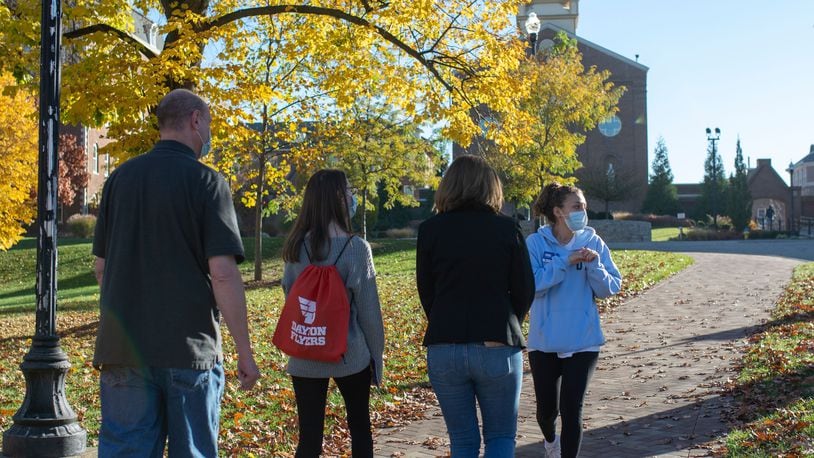Donnell Wiggins, UD’s assistant vice president for strategic enrollment management and dean of admission, said UD is now keeping tours to one tour guide per family, and everyone is required to wear a mask. Campus guests also have to sign a form that says they don’t have any COVID symptoms.
“Pairing families up with one tour guide has been really impactful, because families are able to interact in a way that maybe they weren’t able to before,” Wiggins said. “We’ve created a tour that gives personalized attention to each family and allows people to see the campus in a unique way.”
To keep students safe, UD is not taking tour groups into residence halls. So the university turned a conference room in Albert Emanuel Hall into a dorm room, complete with lofted beds, a mini-fridge, decorations and tape on the floor mapping out the dimensions of various rooms.
“We wanted to show them what it actually looks like,” Wiggins said.
When COVID cases and hospitalizations spiked in Montgomery County this past fall, UD stopped tours temporarily. UD also did not permit families to come to campus if they were from a state on Ohio’s travel advisory list. Wiggins said most families understood these restrictions.
“We’re learning things on a daily basis (about COVID), so being able to adjust and being open to new ways to connect will be critical for both families and institutions,” Wiggins said.
UD also started a virtual tour and virtual one-on-one appointments with UD staff for prospective families.
Other colleges in the area, like Miami University, Ohio State and Wittenberg University have all created virtual tours as well.
Jen McCamis, interim chief recruitment and admissions officer at Wright State University, said when the pandemic started, the admissions staff jumped to build videos and an interactive campus map. Wright State hosts online admissions sessions for prospective students. Student ambassadors also meet up with prospective families online and walk them through the online tours.
Wright State will be hosting some socially distanced open houses in May, June and July. In-person tours are socially distanced and one tour guide is assigned per family.
Wright State had cut out dorm tours but will soon be showing families student housing again. Tour groups will see a fully empty floor of a dorm.
One silver lining in going remote with some admissions activities is that Wright State started a new series of visits this year called Inclusive Excellence, McCamis said.
“We’re really able to focus on what is the experience for African American students and LGBTQIA students on campus and how are they supported, really just focusing on making sure that we make connections for students and making sure that folks know, they have support, and they’re welcome on our campus,” McCamis said.
The Inclusive Excellence series are virtual, one-hour sessions, with admissions staff partnered with organizations on campus, students, faculty and staff to talk about what support services are available and their experiences. The university recently held a women in science session as part of this series. McCamis said this series has been well received and that because the videos are archived, many go back and watch them after the discussion.
“We know that students want to know that they fit in,” McCamis said. “Fit plays such a big role in admissions decisions. And to me, that’s really important in supporting students on their success.”
It’s too early to tell if the pandemic has affected the next incoming class of freshman, Wiggins and McCamis said.
Area colleges have also used their sports venues, like UD Arena and the Nutter Center, to gather groups of prospective or admitted students together and still social distance.
“That’s been a great opportunity because we’re able to have multiple families come from all over in a safe way,” Wiggins said.
Cedarville’s office of admissions is projecting enrollment will grow, as it has for the past 15 years, and credits adaptability when it comes to prospective student visits.
“COVID changed everything about student visits,” said Matthew Dearden, director of undergraduate admissions. “I think our overall view on everything has been let’s get people to campus here if at all possible, in a safe manner and anything that they can’t do while they’re on campus here because of COVID protocols, let’s make sure that they can do in a virtual format.”
Dearden said the admissions department wanted to make sure that the experience wasn’t lacking compared to other years. The university had a limit of one family per tour at the beginning of pandemic, but now they have more.
Dearden’s team has implemented staggered start times for campus visits and take different routes to avoid running into other groups.
Prior to the pandemic, student visits offered a full day of activities, including an admissions presentation, a service in the chapel, a meal in one of the dining facilities, a class of their choice and meetings with professors. However, the close-contact that these activities demanded required admissions staff to alter their usual practices.
Roughly a month after campus shut down in March 2020, the university created a live virtual visits. The experience allowed students and parents to attend an admissions presentation and ask questions in real-time. For a chapel experience, students were directed to the chapel archives.
Cedarville also has a virtual campus and dorm tour, as well as dozens of classes online for prospective students to watch.
Cedarville likely will keep a lot of these online programs in place when the pandemic is over, Dearden said, which would be valuable to students who live out of state or internationally.
“The silver lining of this whole experience has been forcing us to think creatively about ways to get our content and our visit information out there, virtually,” Dearden said.
About the Author
